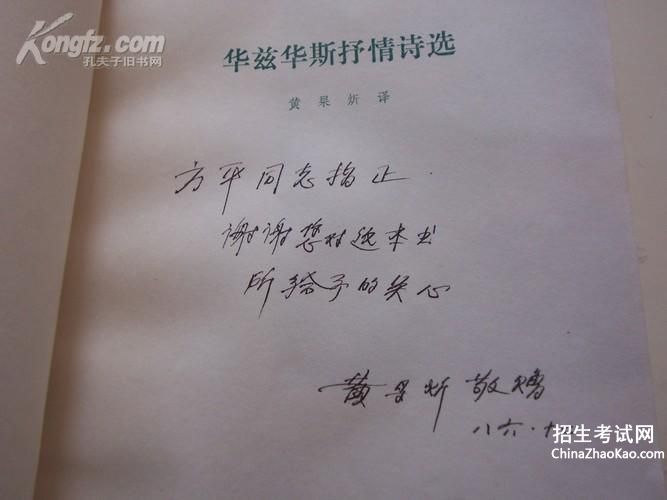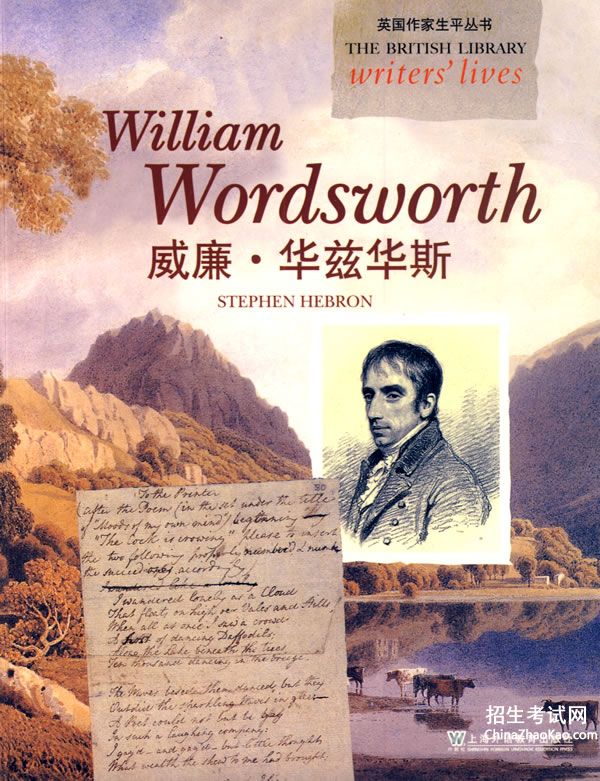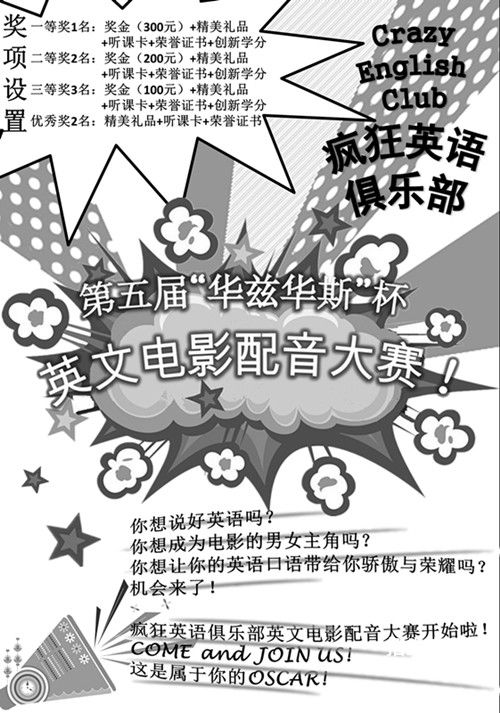导读: 华兹华斯的英文名句(共5篇)华兹华斯英文简介William Wordsworth:William Wordsworth (7 April 1770 – 23 April 1850) was a major English Romantic poet who, with Samuel Taylor Coleridge, help...
华兹华斯英文简介
华兹华斯的英文名句(一)
William Wordsworth:
William Wordsworth (7 April 1770 – 23 April 1850) was a major English Romantic poet who, with Samuel Taylor Coleridge, helped launch the Romantic Age in English literature with their 1798 joint publication, Lyrical Ballads.
Wordsworth's masterpiece is generally considered to be The Prelude, a semi autobiographical poem of his early years which the poet revised and expanded a number of times. The work was posthumously titled and published, prior to which it was generally known as the poem "to Coleridge". Wordsworth was England's Poet Laureate from 1843 until his death in 1850.
Biography:
Early life and education
The second of five children born to John Wordsworth and Ann Cookson,
William Wordsworth was born on 7 April 1770 in Cockermouth in Cumberland — part of the scenic region in north-west England, the Lake District. His sister, the poet and diarist Dorothy Wordsworth, to whom he was close all his life, was born the following year. All of his siblings were destined to have
successful careers. His elder brother Richard became a lawyer in London; John Wordsworth rose to the rank of Captain on a merchantman of the East India Company; and the youngest of the family, Christopher, became Master of Trinity College at Cambridge. After the death of their mother in 1778, their father sent William to Hawkshead Grammar School and sent Dorothy to live with relatives in Yorkshire. She and William did not meet again for another nine years. His father died when he was 13.[1]
Wordsworth made his debut as a writer in 1787 when he published a sonnet in The European Magazine. That same year he began attending St John's
College, Cambridge, and received his B.A. degree in 1791.[2] He returned to Hawkshead for his first two summer holidays, and often spent later holidays on walking tours, visiting places famous for the beauty of their landscape. In 1790, he took a walking tour of Europe, during which he toured the Alps extensively, and also visited nearby areas of France, Switzerland, and Italy. His youngest brother, Christopher, rose to be Master of Trinity College.
Relationship with Annette Vallon
In November 1791, Wordsworth visited Revolutionary France and became
enthralled with the Republican movement. He fell in love with a French woman, Annette Vallon, who in 1792 gave birth to their child, Caroline. Because of lack of money and Britain's tensions with France, he returned alone to England the next year.[4] The circumstances of his return and his subsequent behaviour raise doubts as to his declared wish to marry Annette but he supported her and
his daughter as best he could in later life. During this period, he wrote his acclaimed "It is a beauteous evening, calm and free," recalling his seaside walk with his wife, whom he had not seen for ten years. At the conception of this poem, he had never seen his daughter before. The occurring lines reveal his deep love for both child and mother. The Reign of Terror estranged him from the Republican movement, and war between France and Britain prevented him from seeing Annette and Caroline again for several years.
There are also strong suggestions that Wordsworth may have been depressed and emotionally unsettled in the mid 1790s.
With the Peace of Amiens again allowing travel to France, in 1802 Wordsworth and his sister, Dorothy visited Annette and Caroline in France and arrived at a mutually agreeable settlement regarding Wordsworth's obligations
First publication and Lyrical Ballads
In his "Preface to Lyrical Ballads" which is called the 'manifesto' of English Romantic criticism, Wordsworth calls his poems ' experimental'. 1793 saw Wordsworth's first published poetry with the collections An Evening Walk and Descriptive Sketches. He received a legacy of £900 from Raisley Calvert in 1795 so that he could pursue writing poetry. That year, he also met Samuel Taylor Coleridge in Somerset. The two poets quickly developed a close friendship. In 1797, Wordsworth and his sister, Dorothy, moved to Alfoxton House, Somerset, just a few miles away from Coleridge's home in Nether Stowey. Together, Wordsworth and Coleridge (with insights from Dorothy) produced Lyrical Ballads (1798), an important work in the English Romantic movement. The volume had neither the name of Wordsworth nor Coleridge as the author. One of Wordsworth's most famous poems, "Tintern Abbey", was published in the work, along with Coleridge's "The Rime of the Ancient
Mariner". The second edition, published in 1800, had only Wordsworth listed as the author, and included a preface to the poems, which was significantly augmented in the 1802 edition. This Preface to Lyrical Ballads is considered a central work of Romantic literary theory. In it, Wordsworth discusses what he sees as the elements of a new type of poetry, one based on the "real language of men" and which avoids the poetic diction of much eighteenth-century poetry. Here, Wordsworth also gives his famous definition of poetry askeets "the spontaneous overflow of powerful feelings from emotions recollected in
tranquility." A fourth and final edition of Lyrical Ballads was published in 1805.
Germany and move to the Lake District
Wordsworth, Dorothy, and Coleridge then travelled to Germany in the autumn of 1798. While Coleridge was intellectually stimulated by the trip, its main effect on Wordsworth was to produce homesickness.[4] During the harsh winter of 1798–1799, Wordsworth lived with Dorothy in Goslar, and despite extreme stress and loneliness, he began work on an autobiographical piece
later titled The Prelude. He also wrote a number of famous poems, including "the Lucy poems". He and his sister moved back to England, now to Dove Cottage in Grasmere in the Lake District, and this time with fellow poet Robert Southey nearby. Wordsworth, Coleridge, and Southey came to be known as the "Lake Poets".[5] Through this period, many of his poems revolve around themes of death, endurance, separation, and grief.
华兹华斯 诗歌赏析 两篇
华兹华斯的英文名句(二)【华兹华斯的英文名句】
The Daffodils
Written by William Wordsworth
I wondered lonely as a cloud
That floats on high o'er vales and hills,
When all at once i saw a crowd,
A host,of golden daffodils;
Beside the lake,beneath the trees,
Fluttering and dancing in the breeze.
Continuous as the stars that shine
And twinkle on the Milky Way,
They stretched in never-ending line
Along the margin of a bay:
Ten thousand saw i at a glance
Tossing their heads in sprightly dance.
The waves beside them danced, but they
Out-did the sparking waves in glee:
A Poet could not but be gay
In such a jocund company:
I gazed—and gazed—but little thought
What wealth the show to me had brought:
For oft, when on my couch i lie
In vacant or in pensive mood,
They flash upon that inward eye
Which is the bliss of solitude;
And then my heart with pleasure fills,
And dances with the daffodils.
水仙花
我孤独的漫游,像一朵云
在山丘和谷地上飘荡,
忽然见我看见一群
金色的水仙花迎春开放,
在树荫下,在湖水边,
迎着微风起舞翩翩。
连绵不绝,如繁星灿烂,
在银河里闪闪发光,
它们沿着湖湾的边缘
延伸成无穷无尽的一行;
我一眼看见了一万朵,
在欢舞之中起伏颠簸。
粼粼波光也跳着舞,
水仙的欢欣却胜过水波;
与这样快活的伴侣为伍,
诗人怎能不满心快乐!
我久久凝望,却想象不到
这奇景赋予我多少财宝。
每当我躺在床上不眠,
或心神空茫,或默默沉思,
它们常在心灵中闪现,
那是孤独之中的福;
于是我的心便涨满幸福,
和水仙一同翩翩起舞。
赏析:
《水仙花》是威廉.华兹华斯浪漫主义诗歌的代表作。其口语化的语言是浪漫主义风格的一大特点。文笔朴素清新,自然流畅。这首诗歌强调了诗人对大自然的热爱以及回忆的重要性。

诗歌前两节描写了诗人看到的美丽的自然景色。第三节描写了诗人的内心感觉:欢乐,平和。他把自己比作一朵浮云,在这一片水仙花上俯视着它们。诗人还运用拟人手法(personifies)表达了对大自然的热爱:The cloud wandered,the waves danced,但其重点还是放在水仙花上。他把它们写成“a crowd”,“a host”,“a company”,“They dance and toss their heads”,它们还会表达欢乐愉快(“glee”,“jocund”)的心情呢!
诗歌的最后一节,诗人强调了回忆的重要性。他告诉我们当他处于空虚黯然的心情(in vacant or pensive mood),这一簇簇美丽的水仙花就会出现在他的回忆中(flash upon that inward eye),诗歌中的“inward eye”就是指他的回忆。它们帮助他度过了生命中的困难时期。当我们处在孤独与无助时,我们也可以回忆我们曾经感受大自然的美好时光,让自己感觉好起来。
UPON WESTMINSTER BRIDGE威斯敏斯特桥上
--William Wordsworth华兹华斯
译/猎人hunter560(2010年2月6日 星期六)
Earth has not anything to show more fair:
Bull would he be of soul who could pass by
A sight so touching in its majesty:
This City now doth, like a garment, wear
The beauty of the morning: silent, bare,
Ships, towers, domes, theatres, and temples lie
Open unto the fields, and to the sky;
All bright and glittering in the smokeless air.【华兹华斯的英文名句】
Never did sun more beautifully steep
In his first splendour, valley, rock, or hill;
Ne’er saw I, never felt, a call so deep!
The river glideth at his own sweet will:
Dear God! The very houses seem asleep;
And all that mighty heart is lying still!
Notes:
This poem is written in sonnet form by William Wordsworth describing London, viewed from one of the bridges over the Thames泰晤士河, in the early morning.This poem can be divided into two: the first eight lines (octave) and the next six (sestet). Between these two is a break called a volta which emphasises the traditional change in mood or subject between the octave and sestet. In the first eight, he describes early morning London in detail, and then goes on in the final six to compare the city in that moment to natural wonders. The rhyme scheme is ABBAABBA CDCDCD
The dominating theme in the poem is Nature. London is described with natural scenery. The author describes the beauty of the city as the towers, the cathedrals(church), and the temples. Wordsworth personifies拟人化 the city along with the earth and the sun. This repeated his conviction坚定的信仰 that the city, at this particular point of day, does not clash 不协调with nature but becomes a part of it.The poet describes the calm and the tranquillity乡村的宁静 of the
city. There are neither sounds or noises, there is only silence.
clash 不协调 look bad whenthey are together 大地风光鲜有如此漂亮:
谁对壮丽景色不能欣赏,
那就与公牛的灵魂一样:
这座城市穿上华丽衣裳,
安谧的清晨伴五彩霞光,
船舶、高塔、拱顶、剧场、教堂,
直冲天穹向着田野开放;
在纯净空气里熠熠闪光。
阳光从未如此绚丽辉煌,
沐浴山谷、岩石、山坡之上;
如此召唤以前从未深感,
泰晤士河流淌随心所愿:
上帝啊!千家万户梦正酣;
这颗强大的心沉睡安然!
英美文学资料
华兹华斯的英文名句(三)
《英美文学》(03119)复习大纲
第一部分 英国文学
课程简介
本课程简要介绍英国各个历史断代的主要文学文化思潮,文学流派,主要作家; 本课程要求学生掌握英国文学史上各个时期的文学特点,出现的文学流派以及该时期一至两位重要作家的文学生涯,创作思想,艺术特色及代表作品;并要求学生做到在掌握有关知识理论的基础上使之转换这能力,即能用有关知识和理论来分析英国文学中的相关问题。
课程重点章节简介:
第一章:古代与中世纪英国文学
1. <<贝尔武夫>>

2. 乔叟及其代表作
第二章: 文艺复兴时期
1. 文艺复兴的定义
2. 萨士比亚的戏剧及十四行诗
3. 培根的代表作
第三章: 十七世纪英国文学
弥尔顿的代表作<<失乐园>>、诗剧<<力士参孙>>的主要内容及<<失乐园>>选短
第四章: 启蒙运动时期
新古典主义
伤感主义
笛福及代表作
蒲伯及代表作
第五章: 浪漫主义时期
浪漫主义时期文学的特点
彭斯的创作特点及代表作
华兹华斯的创作特点及代表作
拜伦诗歌的特点及代表作
第六章: 维多利亚时期
维多利亚时期的文学特点
布朗蒂姐妹的代表作
第七章: 现代时期
现代主义文学
汤姆斯.哈代创作特点及代表作
D.H.劳伦斯创作特点及代表作
本课程重点和难点内容简介
第一章:古代与中世纪英国文学:
1.<<贝尔武夫>>简介及在英国文学史上的意义。
2.乔叟及其代表作《坎特伯雷故事集》对英国文学做出的贡献。
3.名词解释“骑士抒情诗”
第二章: 文艺复兴时期:

文艺复兴时期的时间界定
“文艺复兴”的名词解释
“人文主义” 的名词解释
莎士比亚的 “Sonnet 18”的主题
哈姆雷特的性格分析
英语解释《论学习》中的句子
第三章: 十七世纪英国文学:
《失乐园》的主要内容和意义
《失乐园》中撒旦的人物分析
第四章: 启蒙运动时期:
启蒙运动时期的界定
新古典主义的基本主张和特色
伤感主义的名词解释
《鲁滨逊漂流记》中鲁滨逊的人物分析
蒲伯的《论批评》的主题
英文解释《论批评》
第五章: 浪漫主义时期:
浪漫主义时期的界定及文学特点
彭斯的诗歌的特点及其诗作“红玫瑰”
华兹华斯和科勒律治合作的《抒情歌谣集》的重要意义【华兹华斯的英文名句】
华兹华斯的诗歌特点
英文解释华兹华斯“我如行云独自游”中的句子
拜伦“致希腊”的主题并用英语解释其中句子
雪莱“西风颂” 的主题并用英语解释其中句子
第六章: 维多利亚时期
维多利亚时期的文学特点
艾米莉。布朗特的《呼啸山庄》的主题
夏洛特。布朗特的《简。爱》中简。爱的人物分析
第七章: 现代时期
现代主义文学的特点
哈代的代表作及写作特点
劳伦斯小说的主题及人物分析
四、课程内容疏理及应用领域、应用讲解方法
I. Old and Medieval中古 Period
1.The Anglo-Saxon Period (5th century – 1066, the year of the Norman conquest of English )
Beowulf :It is the first long poem in English, which is considered the national epic of the English people. Although Beowulf is a national epic of the English people, but it is a story of the Scandinavians1斯堪的纳维亚(人)的,北欧(人)的
2斯堪的纳维亚语(的),北欧语(的)
2.The Anglo – Norman Period
1)The most prevailing (主要的) of literature in the feudal England is Romance(骑士抒情诗).
名词解释:Romance中世纪骑士故事
---------Romance is a literature form in middle English literature means a long composition in verse or prose form dealing with the life and adventures of a noble贵族 hero, generally a knight(骑士).The knights are unfailingly 无情的devoted to the king and the church. They are commonly described as riding forth to seek adventures, involving in a large amount of fighting for their lords and always encountering romantic love affairs. In romances, loyalty to king and lord is repeatedly emphasized. Romance as a form of literature, is the upper class literature.
2) Geoffrey Chaucer乔叟 – “the father of English poetry” and “the father of English fiction"
His masterpiece – Canterbury Tale 坎特伯雷故事集 is regarded as one of the monumental works in English literature.
论述题:
Briefly introduce the significance of Chaucer in his Canterbury Tale.
His contribution to English literature can be seen in two aspects:
a. Realism: 现实主义
All kinds of people except the highest (king and the top nobility) and the lowest (the very poor laboring people) are represented by these 30 pilgrims.香客,朝圣者,参拜圣地的人 , Besides being the typical representative of her or his own class, each character has her or his own individual qualities. Therefore it gives a true picture of Chaucer’s time.
b. Humanism:人道主义,人文主义
He highly praises man’s energy, quick wit and love of life, thus he reveals his ideas of humanism.
His contribution to English language:
Ever since Norman Conquest, French and Latin were the languages used by the upper classes. Chaucer chose to use the London dialect 方言of his day in his masterpiece. In doing so, he did much in making the London dialect the standard for the Modern English speech.
II、The Renaissance Period (14th to mid-17th)文艺复兴
名词解释:
1、Renaissance :The word “Renaissance” means revival, especially between the 14th and mid-17th century, revival of interest in ancient Greek and Roman culture. Renaissance, therefore, in essence, was a historical period in which the European humanist thinkers made attempts to get ride of conservatism (保守主义) in feudalist Europe and introduce new ideas that expressed the interests of the rising bourgeoisie, 商人阶级;中产阶级,资产阶级to lift the restrictions in all areas placed by the Roman church authorities. Humanism is the essence of the Renaissance.
2.Humanism: Humanism is both the keynote主调音,基音;主旨,要旨,基调
关于坏习惯的名言
华兹华斯的英文名句(四)
(作者简介:英国诗人 )
2、习惯不加以抑制,不久它就会变成你生活上的必需品了。―― 奥古斯丁
(作者简介:古罗马帝国时期基督教思想家,欧洲中世纪基督教神学、教父哲学的重要代表人物。)
3、我一向认为,那些没有恶习的人是很少有美德的。关于坏习惯的名言。――林 肯
(作者简介:美国第16任总统。)
4、我们最坏的恶德,是从幼小的坏习惯开始的。我们的主要教育在乳母手中。――歌德
(作者简介:诗人、自然科学家、文艺理论家和政治人物,歌德是魏玛的古典主义最著名的代表;而作为诗歌、戏剧和散文作品的创作者,他是最伟大的德国作家之一,也是世界文学领域的一个出类拔萃的光辉人物。)
5、如果良好的习惯是一种道德资本,那么,在同样的程度上,坏习惯就是道德上的无法偿清的债务了。――乌申斯基
(作者简介:19世纪俄国教育家)
6、坏习惯像饼子,碎了比保存起来好。――利德益特
(作者简介:英国诗人 )
7、不良的习惯会随时阻碍你走向成名、获利和享乐的路上去。关于坏习惯的名言。―― 莎士比亚
(作者简介:莎士比亚,英国文艺复兴时期伟大的剧作家、诗人,欧洲文艺复兴时期人文主义文学的集大成者。)
8、规劝大多数人,
关于学习的英语名言
华兹华斯的英文名句(五)
1、the way to learn a language is to practice speaking it as often as possible。 学习一门语言的方法就是要尽量多地练习说。
2、other people's interruptions of your work are relatively insignificant pared with the countless times you interrupt yourself。 别人对你工作的干扰与你自己无数次地打断自己相比,微不足道。关于学习的英语名言。
3、if you don't learn to think when you are young, you may never learn。 如果你年轻时没有学会思考,那就永远学不会思考。
4、learning is the eye of the mind。 知识是心灵的慧眼。
5、don't believe that winning is really everything。 it's more important to stand for something。 if you don't stand for something, what do you win 不要认为取胜就是一切,更重要的是要有信念。关于学习的英语名言。倘若你没有信念,那胜利又有什么意义呢?
6、no success in life merely happens。 人生中没有什么成功是纯粹偶然得来的。
7、the shortest answer is doing。 最简单的回答就是干。
8、two heads are better than one。 三个臭皮匠,顶个诸葛亮。
9、it takes a lot of thought and effort and downright determination to be agreeable。 要做到与人融洽相处,需要仔细地思考,认真地努力和痛下决心。
10、to sensible men, every day is a day of reckoning。 -j。w。gardner对聪明人来说,每一天的时间都是要精打细算的。()
11、good is good, but better carries it。 精益求精
12、relax! be patient and enjoy yourself。 learning foreign languages should be fun。 放松点!要有耐性,并让自己快乐!学习外语应该是乐趣无穷的。
13、great hopes make great man。 伟大的理想造就伟大的人。
14、god helps those who help themselves。 天助自助者。
15、if you want to be happy, make yourself useful。让自己做一个有用的人,is no use doing what you like; you have got to like what you do。 不能爱哪行才干哪行,要干哪行爱哪行。
16、growth in wisdom may be exactlyi measured by decrease in bitterness。 智慧的增长可用痛苦的减少来精确衡量。
17、a great man once said it is necessary to dill as much as possible, and the more you apply it in real situations, the more natural it will bee。 一位伟人曾说,反复操练是非常必要的,你越多地将所学到的东西运用到实际生活中,他们就变得越自然。
18、only the selfless can be fearless。 无私才能无畏。
19、when work is a pleasure, life is joy! when work is duty, life is slavery。 工作是一种乐趣时,生活是一种享受!工作是一种义务时,生活则是一种苦役。
20、a man should keep his friendship in constant repair。 只有经常“浇灌”,方能保持友谊长地久
21、the force of the wind tests the strength of the grass。 疾风知劲草。
22、very often a change of self is needed more than a change of scene。 改变自己往往改变更为需要。
23、all things are difficult before they are easy。 凡事必先难后易。
24、when the night is darkest, dawn is nearest。 夜最黑时,黎明最近。
25、learning any language takes a lot of effort。 but don't give up。 学习任何语言都是需要花费很多努力,但不要放弃。
26、nothing is impossible for a willing heart。 心之所愿,无所不成。
27、rome wasn't built in a day。 work harder and practice more。 your hardworking will be rewarded by god one day。 god is equal to everyone! 冰冻三尺,非一日之寒。更加努力地学习,更加勤奋地操练,你所付出的一切将会得到上帝的报答,上帝是公平的。、something attempted, something done。 有所尝试,就等于有所作为。
28、whoever is in a hurry shows that the thing he is about is too big for him。 不管是谁,匆匆忙忙只能说明他不能从事他所从事的工作。
华兹华斯的英文名句相关热词搜索:华兹华斯水仙花英文 外国名家名句华兹华斯
最新推荐成考报名
更多- 歇后语_歇后语大全_歇后语大全及答案_爆笑歇后语
- 大学排名_大学排名2018排行_大学查询_中国大学名单
- 成语大全_四字成语_在线成语词典_成语查询
- 成语接龙大全查询,成语接龙游戏,在线成语接龙
- 全国安全教育平台入口_学校安全教育平台
- 社保查询网-社会保障卡查询,社会保险查询,社保网上查询
- 汉字简体繁体转换_在线繁体字转换工具
- 数字大写转换|人民币金额(数字)大小写转换在线工具
- 年龄计算器实际岁数计算器 - 周岁虚岁计算器
- 产假计算器-算产假计算器在线2018-2018年产假自动计算器
- 预产期计算器-怀孕孕期计算器-怀孕天数计算
- 中国文库网-教育资源网-范文文章
- 邮编区号查询网
- 致富商机网-致富点子_创业项目
- 创业项目网--最热门的投资项目
- 中国邮政邮编查询号码
- 电话区号查询
- 全国车牌号归属地大全
- 在线网速测试|宽带速度测试
- 人民币汇率查询
- ●理财有没有风险 金融互联网理财
- ●qq网名
- ●2016最新伤感说说
- ●谈笑风生造句
- ●读书的名言
- ●资产清查报告
- ●贫困户申请书
- ●财务自查报告
- ●离婚起诉书
- ●赞美老师的演讲稿
- ●车间管理
- ●车辆购置税
- ●跨越百年的美丽读后感
- ●跟女友离别的话
- ●超市管理制度
- ●起诉状范本
- ●赠别诗大全
- ●描写夏天的句子
- ●描写友谊的诗句
- ●迁户口申请书
- ●转正申请表范本
- ●这个杀手不太冷台词
- ●运动会稿子精选
- ●那么那么造句
- ●送给男朋友的情话大全
- ●钳工实训报告
- ●霸气说说大全
- ●骂人不带脏字的
- ●幼儿园见习个人总结
- ●追女孩子的短信

